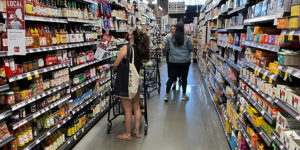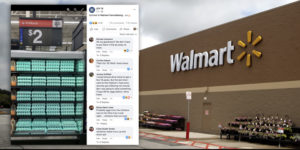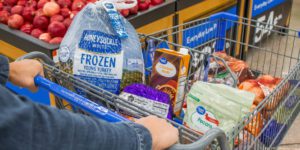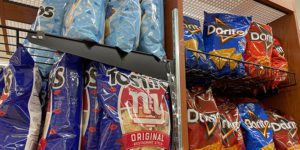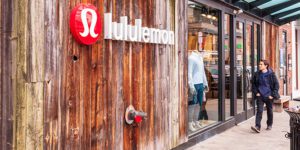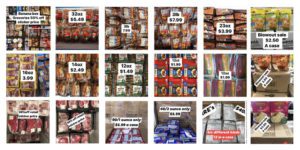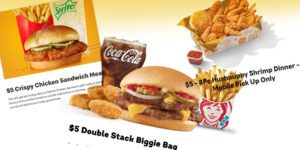Are You a Retail Tech Leader? Sponsor Our Newsletter
The Economy News
Inflation gives Americans another reason to cook at home
Domino’s Pizza last week said its research shows, to avoid delivery costs, more customers prepare meals during inflationary times rather than order pizza. Will high inflation, including grocery, contribute more to increasing or decreasing the appeal of home cooking?
Is inflation giving grocers a bad rap?
Shoppers believe grocers are making 14 times more profit than they actually are and also believe food-at-home inflation is about two times higher than reality, according to a new dunnhumby analysis. Are grocers in a “precarious position with their brand perception” in the face of rampant food inflation?
Walmart gets the attention of shoppers with egg-ceptional prices
Walmart is known for its everyday low prices on products across the store, but a recent offer of a carton of 18 eggs for $2 at a store in Kentucky raises questions about how this particular location was able to offer a price so low. How much are Walmart and other large retailers able to influence pricing on commodities such as eggs?
Should grocers be demanding price decreases from suppliers?
At a virtual meeting in December, Whole Foods implored suppliers to lower costs on packaged groceries as inflation moderates. Do grocers have the leverage it takes to strong-arm their suppliers into reducing prices?
2023 could be the year of the recession that never happened
The economic recession of 2023 will not be televised. That’s because it appears unlikely to happen, despite predictions of its inevitability from economists, bankers, analysts and others. What factors do you think will have the greatest impact on retail industry performance for the balance of 2023?
Tractor Supply is just getting started with its market share grab
It’s good to be Tractor Supply. The retailer is on a multiyear winning streak, posting record sales and profits and grabbing market share from a long list of competitors. How long can Tractor Supply keep its winning streak going?
Has luxury retailing become more recession-resistant?
A new study from Bain & Co. concludes that, while luxury spending‘s growth is expected to slow in 2023 following two gangbuster recovery years, the sector has become “more resilient to recession.” Do you agree that the luxury goods sector has become less susceptible to the impact of downturns?
Will consumer anger drive down inflation?
Consumers are fed up with escalating inflation, prompting some companies to restrain their price hikes to offset cost pressures. Will consumer resistance to higher prices likely be the primary factor driving down inflation?
Nordstrom gets snagged by apparel markdown pressures
Nordstrom last week became the latest retailer in the apparel space to lower its outlook as it found that deeper discounts were required to clear slow-moving holiday merchandise. Is Nordstrom’s shortfall likely more reflective of the broader challenges facing the apparel category or its own management strategies and processes?
Retailers should be prepping now for economic recovery
The U.S. may or may not experience a recession in the coming year, but in either case retailers should be strategizing and hiring with the era that follows the economic dip in mind, according to Dr. Ira Kalish, chief global economist at Deloitte. Do you agree with Dr. Kalish’s advice that retailers should prepare for a post-downturn recovery in their hiring, spending and strategizing?
Consumers get some relief as inflation eases
American consumers continued to spend as prices rose steadily higher from 2021 to June 2022. Will they keep up the shopping pace as prices go in the opposite direction? How might a further easing of inflation affect consumer spending?
Will 2023 be all about value?
With customers continuing to seek lower-priced shopping options due to inflation, the major players in value retailing are already far outpacing others in opening new stores in 2022 and appear to be riding mighty tailwinds heading into 2023. How much of the expansion success by dollar stores, budget grocers and other value-first chains depends on enduring inflation?
Study sees The Great Resignation heating up in 2023
In early 2021, reports of mass numbers of employees leaving jobs in search of greener, more lucrative pastures led to the phenomenon known as The Great Resignation. A new survey suggests that the resignations may just be getting started. Do you see The Great Resignation continuing or switching gears in 2023?
Did holiday promotions drive gains or only pain?
In the first major assessment of holiday selling, Mastercard estimated U.S. retail sales grew 7.6 percent year-over-year from November 1 through December 24. The performance topped Mastercard’s prediction that called for a 7.1 percent increase but fell short of last year’s 8.5 percent gain. What’s your feeling on how the 2022 holiday selling season went for U.S. retail?
7-Eleven tops best grocery store list
These days, the favorite grocery store in the U.S. is not even a supermarket, a new survey says. Why are more people shopping at 7-Eleven and other convenience stores for meals in the current economic environment?
Big Lots is going country
Big Lots is looking to leave the city life behind as it sees plenty of opportunities to grow in places with wide open spaces. Will a greater emphasis on operating stores in small towns and rural areas and away from more competitive urban markets prove successful for Big Lots?
Will persistent theft compel Walmart to raise prices or close stores?
Walmart CEO Doug McMillon yesterday told CNBC that his company has a growing theft problem. Mr. McMillon said that theft has reached levels that are “higher than what’s historically been” the case for the retailer. “If that’s not corrected over time, prices will be higher, and/or stores will close,” he said. Do you see Walmart raising prices or closing stores in some areas in response to increasing theft?
The sky won’t fall, and other retail predictions for 2023
The year 2023 is going to be better at retail than expected, especially for those companies that appeal to the higher and lower ends of the market. Those catering to the middle will likely have a tough go of it. How do you think the national economy will affect consumer behavior and retail in 2023?
Do DoorDash layoffs signal tough times ahead for same-day delivery services?
Same-day delivery service DoorDash recently announced the layoff of 1,250 corporate workers, raising questions as to whether this is a result of a company in trouble, a contracting vertical, an impending recession or elements of two or three of the above. Are the layoffs at DoorDash a sign of things to come for delivery companies or are they commensurate with changes in the broader retailing market?
Retailers find inflation is often about location, location, location
Inflation is a top concern for both businesses and consumers currently, and rightfully so as the U.S. trend continues to remain high. What do you see as the most effective tactics for retailers trying to hold the line on inflation for their customers?
Retailers are using newfound clout to put the squeeze on suppliers
With inventories elevated in many categories and the economy slowing amid inflationary pressures, larger retailers are using reclaimed leverage to cancel orders, fight price increases and seek out concessions from suppliers. Do you see indications that retailers regained leverage against their supplier base amid excess inventories and inflationary pressures?
Can Walmart hold onto the new, wealthier customers it is picking up?
Walmart’s savings message is resonating with Americans across income levels and helping the company dramatically reduce its inventory in the process. How likely is it that the new customers coming to Walmart for groceries will stick with the chain once inflation becomes less of a factor?
Retailers have scaled way back on seasonal help for Christmas
Amid a continued tight labor market, holiday help appears to be less in demand this year due to the souring economy. Is it prudent or hasty to significantly pull back on seasonal hires amid inflationary pressures and the uncertain economy?
The stigma around secondhand gifting is fading away
With inflation top of mind for many, surveys show consumers are more eager to buy secondhand items as holiday gifts this year to save money. Are the drivers behind gifting resale items this holiday different from past years?
Aldi and Walmart are turning back the clock on inflation for Thanksgiving
Aldi and Walmart are running Thanksgiving meal promotions that promise to help their customers save as though grocery prices haven’t spiked 13 percent in 2022. Are Americans significantly more price sensitive heading into this year’s Thanksgiving Day feasts than they were in 2021?
Will freight operators serve as a canary in the retail coal mine?
Freight demand is dropping, as reported by some of the biggest long haul freight companies in the U.S. The trucking firms say they have seen demand for their services wane somewhat at a time when they normally are at their busiest. What do declines in cargo imports and freight demand say about the sales outlook for retail over the next six months to a year?
Canada investigates grocers over charges of price gouging
With inflation driving grocery prices sky-high over the last year, the Canadian government is stepping in to determine whether or not grocers have been gouging. Do you think U.S. grocers will come under pressure similar to what is taking place in Canada should food inflation continue to rise?
How can grocers prevail in inflationary times without winning on price?
Grocers not known for rock-bottom prices can minimize the damage in competing against low-price leaders — and potentially strengthen bonds with customers — by keeping price gaps tight while using best practices in executing mass promotions, communications, personalization and private branding. How can traditional grocers best compete in inflationary periods against low-priced leaders?
Do grocers have a price perception problem?
Food prices are rising, no doubt, but apparently American consumers think they are paying way more than price tracking statistics show is the reality. Does the grocery industry have a price perception problem?
Will most Americans spend Black Friday shopping on their phones?
Black Friday still draws large crowds to malls, shopping centers and stores, but a large percentage of Americans will spend the day opening apps and shopping from the comfort of their homes. What do you see as the most significant differences in the way Americans will shop for the holidays this year compared to 2021?
Did Walmart just guarantee it will be the easiest place to shop for Christmas?
Walmart is known for its low prices and the retailer seems determined to also be synonymous with convenient holiday shopping with new programs that promise to take much of the hassle of buying and returning Christmas gifts this year. How much appeal will Walmart’s return options have for Christmas gift shoppers this year?
Dollar General plans to expand its selection of $1 items
Dollar General says it is not abandoning the pricing on its selection of $1 products, even as inflation continues to drive retail prices up nationwide. How important is the $1 price point to Dollar General shoppers?
Is now the right or wrong time for retailers to invest big in their businesses?
Many retailers saw dollar sales slow and profit margins drop over the first six months of the year and some have responded to this situation by cutting back on capital expenditures. Should retailers currently struggling with sales and profits seek to increase or decrease their capital expenditures at this time?
Is ‘shrinkflation’ a better option than charging higher prices at retail?
A recent Morning Consult survey concludes that only 25 percent of U.S. adults have failed to notice “shrinkflation” in any grocery categories, and many that have are seeking alternatives. How open should retailers be to accepting shrinkflation moves from vendors?
Is Lululemon inflation proof?
Lululemon raised its outlook for the year after reporting second-quarter results that came in well above expectations. The stellar performance came despite concerns over promotions across the apparel space and a slowdown in the athleisure category. What’s driving the recent outperformance by Lululemon?
Should grocers make a big deal out of freezing prices?
On Walmart’s second-quarter conference call, Doug McMillon, CEO, said the retailer’s merchants are focused on “holding prices down or rolling them back” across categories based on demand. Should retailers be doing more to publicize their efforts to selectively hold or reduce prices at this time?
What tradeoffs are consumers willing to make to stretch their food dollars?
A new survey finds 76 percent of U.S. consumers saying their family has changed how they buy food with prices on the rise. Do you suspect grocery shopping behavior will follow patterns seen in recent downturns or do escalating food prices and other factors throw that out of alignment?
Salvage stores achieve sales growth by selling ‘unsellable’ goods
In an inflationary era when customers are increasingly strapped for cash and hunting for discounts, a category of ultra-low-priced grocers that sell the unsellable is growing in popularity. Do you expect mainstream grocers to change their protocols for “unsellable” CPG items if inflation persists?
Are inflation bonuses worth it for retailers?
Lowe’s is spending a total of $55 million on bonuses for hourly store associates to help them offset the sting of inflation, which has remained near 40-year highs for much of summer. Has inflation made retailing jobs more or less attractive to those seeking work?
Is Target ready for what comes next?
Target is ready to get back to its more profitable ways. That was the message yesterday from CEO Brian Cornell on the chain’s second-quarter earnings call with analysts. What do you see as Target’s strengths and weaknesses as it moves into the back half of 2022?
Walmart under-promised and over-delivered in the second quarter
Walmart is apparently capable of surprising itself. The retailer reported better than expected sales and earnings for its second quarter just weeks after lowering its forecast. What is your takeaway from Walmart’s better-than-expected results from the second quarter as it relates to the national economy and retail?
Have restaurant meals become a better deal than food from grocery stores?
The conventional wisdom has long been that you are financially better off making food at home than splurging on eating out. But the inflationary economy might be flipping that logic on its head. Will U.S. consumers shift more food dollars to restaurants through the balance of 2022?
Is inflation the biggest back-to-school story?
Deloitte, KPMG and Mastercard all issued “Gold Star” back-to-school spending forecasts in the range of 7.5 percent to nine percent, attributing spending increases in part to inflation. Do you agree that back-to-school is largely an “essential category” and somewhat immune to inflationary pressures?
Is inflation transforming dollar stores into bigger grocery destinations?
A recent study confirms that many of the most price-sensitive consumers are shopping more frequently at dollar stores as they’ve been unable to make ends meet by switching to cheaper brands or smaller sizes at regular supermarkets. Are dollar stores well positioned to grab grocery market share in the coming months?
Is retail now facing a warehouse crisis?
With supply chain bottlenecks easing, a scarcity of warehouse space is promising to replace shipping container shortages as the biggest headache in the global supply chain. Is procuring adequate warehouse space a short-term, long-term or not much of a problem for retail?
Americans turned to food waste apps as grocery prices rose
In pursuit of new ways to cut grocery costs as inflation continues to threaten household budgets, families have begun turning to apps that let them circumvent paying full price by pointing them right to the food that is nearing its sell-by date. How do you see the increasing popularity of food waste apps affecting the grocery and foodservice industries?
Should marketing have more control over pricing?
Traditionally, chief marketing officers have oversight over promotions to get products out, but not much influence on initial pricing as products come in. Should marketing play a larger role in setting initial pricing, particularly during inflationary times?
New stores are opening in malls, inflation or no
Some say a recession is on the way; others say it is already here, but according to the biggest owner of U.S. shopping malls, the threat of an economic downturn is not deterring retailers from opening new mall locations. How likely is it that mall occupancy rates will remain at the current level or higher over the next two years?
Are grocers profiteering from inflation?
In a tweet Tuesday, Gail Vaz-Oxlade, a Canadian celebrity money expert, called for a boycott of Loblaws, encouraging followers to “join in sending a message to the Loblaws group that you do NOT appreciate their profiting and calling it ‘inflation.’” How would you define profiteering in the current inflationary climate and are certain grocers and food manufacturers guilty?
Will the ‘Buy Now, Pay Later’ model overcome economic and regulatory challenges?
“Buy Now, Pay Later” services saw explosive adoption as e-commerce upshifted into a higher gear during the pandemic, but are now facing questions over their sustainability. Are rising interest rates, inflation and regulatory pressures short-term hurdles for BNPL loan providers or a threat to their survival?
© 2025 RetailWire · Privacy Policy · Terms & Conditions · Community Guidelines · Sitemap · Do Not Sell My Data


